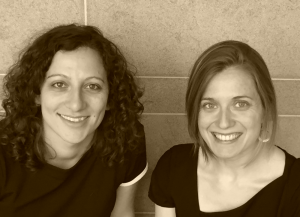The Department of Foreign Languages & Literatures not only just changed its name to Department of Languages, Literatures and Cultures but has also added two new cutting-edge faculty members to round out its already diverse specializations in ten different languages, literatures and cultures. Assistant Professor Sophie Esch, a Latin American cultural studies scholar who works on Mexican and Central American literature and music, was hired last year. Assistant Professor Silvia Soler Gallego, a translation and interpretation scholar who works on audiovisual translation in museums, was hired this year.

Professor Esch is currently working on a book on the cultural and political significance of weapons in the context of several armed conflicts in Latin America. Studying photos, songs, and novels through the lens of the firearm, her book tells the story of the Mexican Revolution, the Sandinista Revolution and the current drug war. From Emiliano Zapata or Pancho Villa with cartridge belts crossed across their chest to songs about guerrilla warfare to the gilded AK-47s flaunted by drug lords, she shows how these artifacts shape conceptions of politics and modernity. Professor Esch received her M.A. in Latin American Literature, Political Science and North American Studies from the Free University of Berlin and her PhD in Latin American Literature and Culture from Tulane University in New Orleans. She has traveled extensively in Central America and Peru and has completed research and study stays at the Colegio de Mexico and the Institute for the History of Nicaragua and Central America in Managua.
At CSU, she teaches advanced courses in Latin American literature and culture. Some of her courses are panoramic, some focused on Mexico or Central America, and some have a thematic focus such as revolutions, outlaws, or the environment. In her Latin American cultures courses, students write articles on the female revolutionaries for Wikipedia and annotate folk ballads. Last year, students put on a short theatre play based on the novel A Hundred Years of Solitude for the Gabriel García Márquez symposium. “I have been so impressed by the students at CSU,” says Professor Esch, “they really engage with course materials. One student wrote me from a trip to Santa Fe to tell me that she recognized the Spanish colonial structure we had talked about in class and could explain it to her friends. Another student wrote a remarkable poem about the missing students in Mexico as part of a class project, which she then was able to publish in Mexico.”
Professor Soler started at CSU this semester. She works in Translation Studies, Disability Studies and Museum Studies. Her main research interest is museum audio description, a means to make museums more accessible. In her research, she looks at how artworks, for instance Monet’s Water Lilies at the New York Museum of Modern Art, are described by educators and professional audio describers to assist visitors with a visual impairment to construct a mental image of the works. After completing a study of audio description at American and British art museums, including MoMA, Tate Modern and London Royal Academy of Arts, she is now working on a comparative intercultural study incorporating Spanish and French museums. She is a founding member of Kaleidoscope Universal Access, a nonprofit association dedicated to fostering universal access to culture and information through translation and interpreting. She has worked as a freelance translator, mainly in English-Spanish translation projects in the computing field. Professor Soler received her MA in Translation and Interpreting from the University of Granada and her PhD in Translation at the University of Cordova, Spain. Before coming to CSU she was a postdoctoral fellow at the University of Cordova, and has completed research stays at Rutgers University and the ISIT at Paris.
Translation courses have been an important part of the department’s curriculum but with the arrival of Soler the department is able to expand its offerings and is working to develop a professional translation program. She reached out to local translators for International Translation Day and is in charge of teaching introductory and advanced courses in Spanish-English translation and interpreting, literary translation and advanced Spanish communication skills. Her students explore fundamental concepts of translation and interpreting theory and history before practicing with concrete examples. In the Spanish-English translation courses, students translate the accessibility web page of the MoMA, and create subtitles for a film by famous Catalonian director Isabel Coixet. They also practice interpreting for healthcare or business settings through in-class role-play activities. The graduate course in Literary Translation focuses on contemporary prose fiction, drama and poetry in French, Spanish and English. Students learn to tackle complex problems, such as how to translate metaphors in the poems of CSU professor and Colorado poet Laureate Mary Crow, Mexican-American cultural elements in Sandra Cisneros’ novels, and ideology in Michel Houellebecq’s works. Soler is happy to be at a university with many points of connection with her research: “The fact that this department offers minors in a great variety of languages, and courses in American Sign Language, is a proof of its commitment to intercultural understanding, diversity, and social justice,” she said. “Given my personal and research interests, this is a wonderful place for me to be. I consider that part of my job here is to incorporate these issues and values into my courses, through the texts students translate, and the communicative situations they have to mediate in.”
